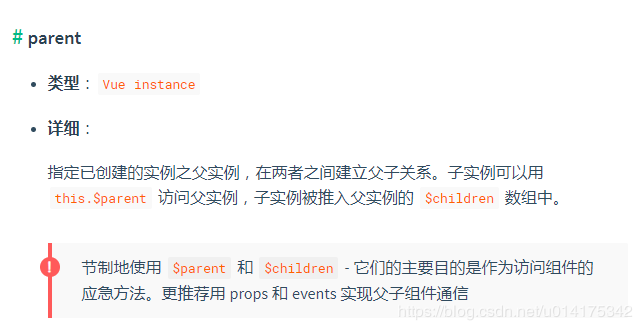一、props / $emit
下面通过一个例子说明父组件如何向子组件传递数据:在子组件article.vue中如何获取父组件section.vue中的数据articles:['红楼梦', '西游记','三国演义']
// section父组件 <template> <div class="section"> <com-article :articles="articleList"></com-article> </div> </template> <script> import comArticle from './test/article.vue' export default { name: 'HelloWorld', components: { comArticle }, data() { return { articleList: ['红楼梦', '西游记', '三国演义'] } } } </script> // 子组件 article.vue <template> <div> <span v-for="(item, index) in articles" :key="index">{{item}}</span> </div> </template> <script> export default { props: ['articles'] } </script>
总结: prop 只可以从上一级组件传递到下一级组件(父子组件),即所谓的单向数据流。而且 prop 只读,不可被修改,所有修改都会失效并警告。
2. 子组件向父组件传值
对于
$emit 我自己的理解是这样的: $emit绑定一个自定义事件, 当这个语句被执行时, 就会将参数arg传递给父组件,父组件通过v-on监听并接收参数。 通过一个例子,说明子组件如何向父组件传递数据。 在上个例子的基础上, 点击页面渲染出来的ariticle的item, 父组件中显示在数组中的下标// 父组件中 <template> <div class="section"> <com-article :articles="articleList" @onEmitIndex="onEmitIndex"></com-article> <p>{{currentIndex}}</p> </div> </template> <script> import comArticle from './test/article.vue' export default { name: 'HelloWorld', components: { comArticle }, data() { return { currentIndex: -1, articleList: ['红楼梦', '西游记', '三国演义'] } }, methods: { onEmitIndex(idx) { this.currentIndex = idx } } } </script> <template> <div> <div v-for="(item, index) in articles" :key="index" @click="emitIndex(index)">{{item}}</div> </div> </template> <script> export default { props: ['articles'], methods: { emitIndex(index) { this.$emit('onEmitIndex', index) } } } </script>
二、 $children / $parent

// 父组件中 <template> <div class="hello_world"> <div>{{msg}}</div> <com-a></com-a> <button @click="changeA">点击改变子组件值</button> </div> </template> <script> import ComA from './test/comA.vue' export default { name: 'HelloWorld', components: { ComA }, data() { return { msg: 'Welcome' } }, methods: { changeA() { // 获取到子组件A this.$children[0].messageA = 'this is new value' } } } </script> // 子组件中 <template> <div class="com_a"> <span>{{messageA}}</span> <p>获取父组件的值为: {{parentVal}}</p> </div> </template> <script> export default { data() { return { messageA: 'this is old' } }, computed:{ parentVal(){ return this.$parent.msg; } } } </script>
要注意边界情况,如在
#app上拿$parent得到的是new Vue()的实例,在这实例上再拿$parent得到的是undefined,而在最底层的子组件拿$children是个空数组。也要注意得到$parent和$children的值不一样,$children 的值是数组,而$parent是个对象三、provide/ inject
provide/ inject 是vue2.2.0新增的api, 简单来说就是父组件中通过provide来提供变量, 然后再子组件中通过inject来注入变量。
注意: 这里不论子组件嵌套有多深, 只要调用了
inject那么就可以注入provide中的数据,而不局限于只能从当前父组件的props属性中回去数据
// A.vue <template> <div> <comB></comB> </div> </template> <script> import comB from '../components/test/comB.vue' export default { name: "A", provide: { for: "demo" }, components:{ comB } } </script> // B.vue <template> <div> {{demo}} <comC></comC> </div> </template> <script> import comC from '../components/test/comC.vue' export default { name: "B", inject: ['for'], data() { return { demo: this.for } }, components: { comC } } </script> // C.vue <template> <div> {{demo}} </div> </template> <script> export default { name: "C", inject: ['for'], data() { return { demo: this.for } } } </script>
四、ref / refs
ref:如果在普通的 DOM 元素上使用,引用指向的就是 DOM 元素;如果用在子组件上,引用就指向组件实例,可以通过实例直接调用组件的方法或访问数据, 我们看一个ref 来访问组件的例子:// 子组件 A.vue export default { data () { return { name: 'Vue.js' } }, methods: { sayHello () { console.log('hello') } } } // 父组件 app.vue <template> <component-a ref="comA"></component-a> </template> <script> export default { mounted () { const comA = this.$refs.comA; console.log(comA.name); // Vue.js comA.sayHello(); // hello } } </script>
五、eventBus
eventBus 又称为事件总线,在vue中可以使用它来作为沟通桥梁的概念, 就像是所有组件共用相同的事件中心,可以向该中心注册发送事件或接收事件, 所以组件都可以通知其他组件。
eventBus也有不方便之处, 当项目较大,就容易造成难以维护的灾难
类似事件订阅与发布
六、Vuex
七、localStorage / sessionStorage
八 $attrs与 $listeners
在
vue2.4中,为了解决该需求,引入了$attrs 和$listeners , 新增了inheritAttrs 选项。 在版本2.4以前,默认情况下,父作用域中不作为 prop 被识别 (且获取) 的特性绑定 (class 和 style 除外),将会“回退”且作为普通的HTML特性应用在子组件的根元素上。接下来看一个跨级通信的例子:// app.vue // index.vue <template> <div> <child-com1 :name="name" :age="age" :gender="gender" :height="height" title="FE攻城狮从零到壹" ></child-com1> </div> </template> <script> const childCom1 = () => import("./childCom1.vue"); export default { components: { childCom1 }, data() { return { name: "ghui", age: "18", gender: "男", height: "183" }; } }; </script> // childCom1.vue <template class="border"> <div> <p>name: {{ name}}</p> <p>childCom1的$attrs: {{ $attrs }}</p> <child-com2 v-bind="$attrs"></child-com2> </div> </template> <script> const childCom2 = () => import("./childCom2.vue"); export default { components: { childCom2 }, inheritAttrs: false, // 可以关闭自动挂载到组件根元素上的没有在props声明的属性 props: { name: String // name作为props属性绑定 }, created() { console.log(this.$attrs); // { "age": "18", "gender": "男", "height": "183", "title": "FE攻城狮从零到壹" } } }; </script> // childCom2.vue <template> <div class="border"> <p>age: {{ age}}</p> <p>childCom2: {{ $attrs }}</p> </div> </template> <script> export default { inheritAttrs: false, props: { age: String }, created() { console.log(this.$attrs); // { "gender": "男", "height": "183", "title": "FE攻城狮从零到壹" } } }; </script>